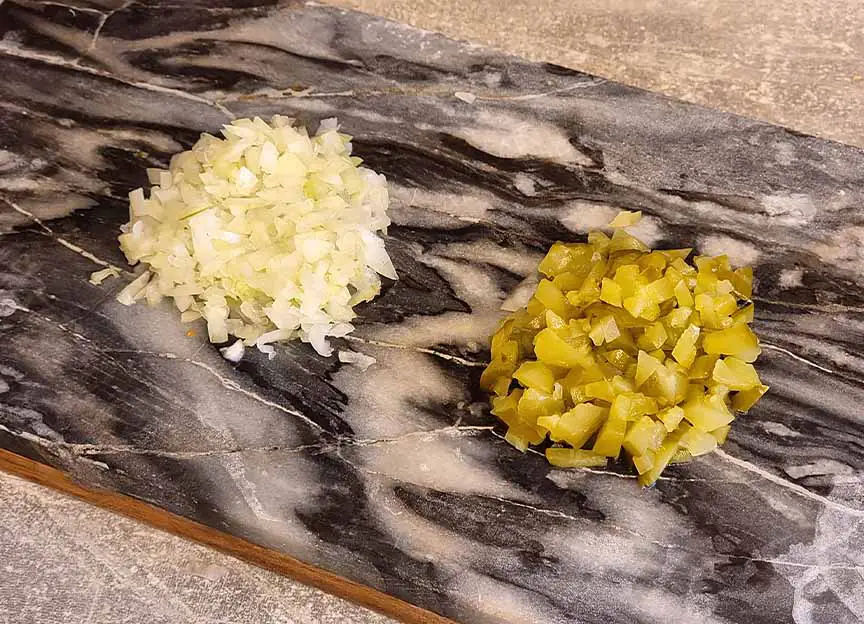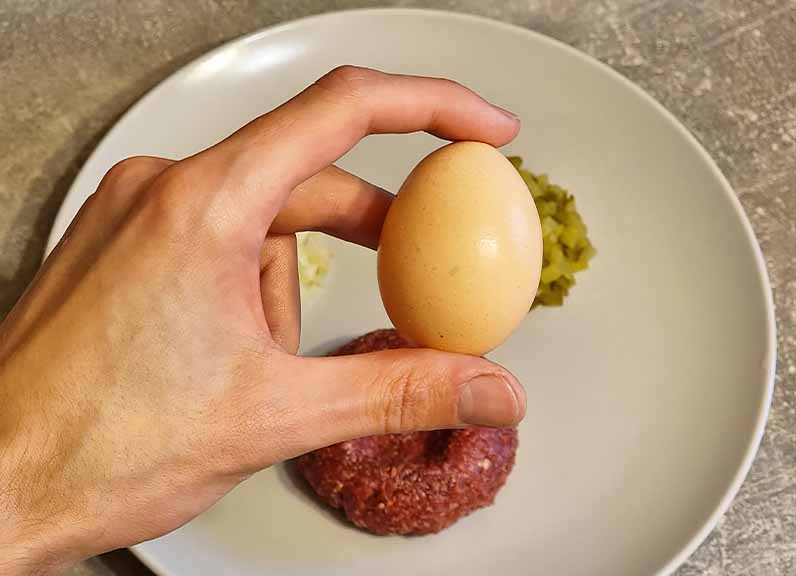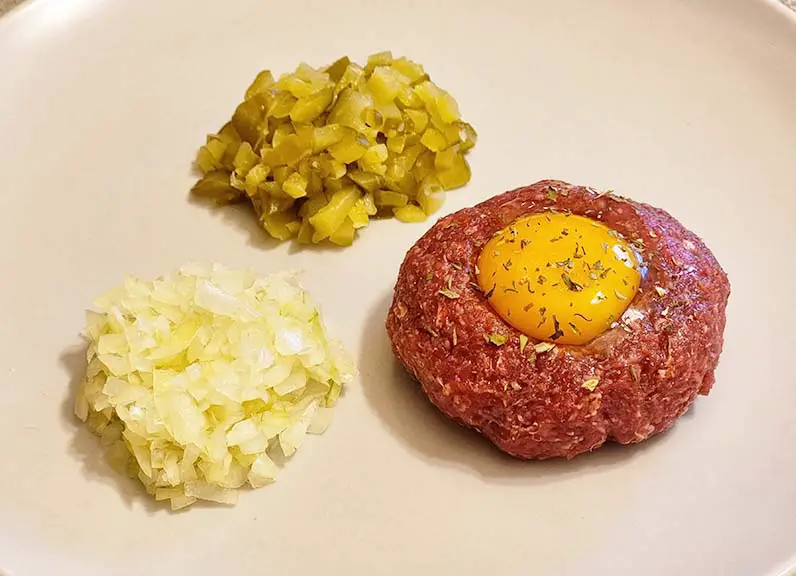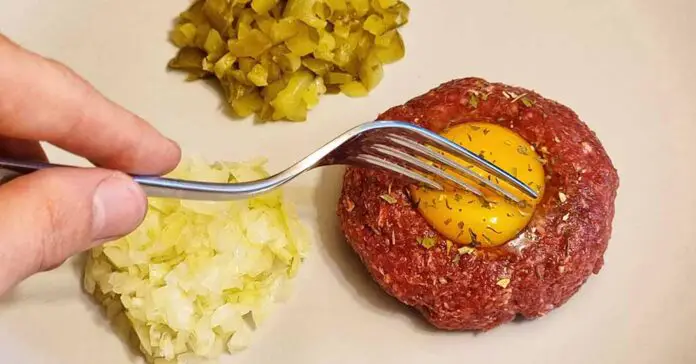You’ve probably already heard of steak tartare or beef tartare somewhere. It’s a delicious dish that has been enjoyed by foodies around the world for long years now. If you’re curious about what this dish exactly is and why it’s so popular, then you’ve come to the right place! In this article, we’ll take an in-depth look at steak tartare, from its history and ingredients to how it’s commonly prepared and served. So grab your fork and knife, because you’re about to learn some tasty facts about steak tartare!
The unique flavor of steak tartare lies in its preparation process. To make it correctly, cooks must finely mince the beef before seasoning it with spices and other ingredients which we’ll cover in a short while. The result is a delectable combination of flavors that will surely please your taste buds. So if you’re looking for new gastronomic experiences, then steak tartare might just be a good meal to try!
Check out also: How To Serve And Eat Beef Tartare (Quick Tatar Recipe)
- “Tartare” – Dish Origins
- Steak tartare – what is it made of?
- Types Of Beef Used
- Traditional Preparation Techniques
- Spices And Seasonings
- Served With Accompaniments
- How To Enjoy Tartare Safely
- Are There Any Health Risks Associated With Eating Steak Tartare?
- Popularity Of Tartare Around The World
- Steak tartare – that’s it!
“Tartare” – Dish Origins
The word ‘tartare’ has its origin in the French language, and it is believed to be referencing the Tatar people from central and western Russia. How much the original “tartare” had to do with the Tatar culture is still a matter of debate.
The earliest mentions of “tartare” can be traced back to the 19th century, but they weren’t exactly referring to the beef tartare dish we know today. Instead, it was referencing a tartar sauce which you can find on supermarket shelves in modern variants.
It wasn’t until much later that the word “tartare” was used to refer to the beef tartare dish in a form closer to that which we all know today. Not much else is known about the earliest history of tartare, as its oldest mentions are largely unknown.
Steak tartare – what is it made of?

A steak tartare is a dish consisting of finely chopped or minced raw beef, usually prepared with onions, pickled cucumber, and various other toppings and seasonings. It is often served as an appetizer or a main course. Steak tartare is believed to have originated in the early 19th century in France and has since become popular in other countries as well.
The most common way to prepare steak tartare is to mix the raw beef with seasonings such as garlic, pepper, Worcestershire sauce, and herbs like parsley. The mixture is then shaped into a patty and served either on its own or with accompaniments such as eggs, pickles, capers, onions, and mustard. It is typically eaten solo or with additional topings such as pickled vegetables. Another way is to simply form the meat into a patty and serve the other ingredients and toppings beside it – this is my personal preference.
Steak tartare can also be prepared using different types of meat such as turkey or fish, though the traditional recipe calls for beef. This dish has become quite versatile over the years; there are many variations including adding different ingredients such as mushrooms or olives to create new flavors. No matter how it’s prepared though, steak tartare remains a classic dish that continues to be enjoyed around the world.
When done correctly, steak tartare can be an incredibly flavorful culinary experience that offers both texture and flavor complexity in every bite.
Types Of Beef Used
Now that we’ve explored the traditional preparation techniques for steak tartare, let’s take a closer look at the types of beef used in this iconic dish. Traditionally, best cuts for steak tartare are tenderloin and sirloin. However, other cuts of beef can be used as well. Ground beef is a popular choice, as it’s easy to prepare and provides a juicy texture.
No matter which cut you choose, make sure to select high-quality beef with a slight amount of marbling. The fat content can help ensure that your steak tartare is both flavorful and juicy!
Did you know? – Many stores offer pre-made minced meat packs meat specifically for quick tartare preparation. Check if your local store has one of these. Their tartare designation will be clearly stated somewhere on the label. We even have a neat quick tartare recipe in which we kind of cheat using pre-made tartare mix! Check it out here: How To Serve And Eat Beef Tartare (Quick Tatar Recipe)
Traditional Preparation Techniques
Having explored the origins of steak tartare, it’s time to look at how the dish is traditionally prepared. Since its creation in the early 19th century, steak tartare has been served in many different ways around the world. However, there are certain steps that should be followed when making a traditional steak tartare.
The first step is to select high-quality beef. The best cuts for steak tartare are tenderloin and sirloin. Once you have your beef, you’ll need to finely chop it into small pieces and season it with salt, pepper, and other herbs and spices of your choosing.
Once the meat is ready, it should be mixed with other ingredients such as onions, capers, Worcestershire sauce, mustard, pickles, and egg yolk. This mixture should then be then formed in a patty-like shape and served on a plate with some additional toppings beside it. We’ll get to the toppings and seasonings in just a little while.
Spices And Seasonings
Seasonings are a key component of steak tartare, as they often can turn a simple dish into something truly special. To enhance the flavor of your steak tartare, you’ll want to use a variety of spices and herbs. Popular seasonings include salt, pepper, paprika, garlic powder, onion powder, cayenne pepper, and fresh parsley or chives. These are mixed into the meat after its already cut.
By combining flavorful spices and herbs with high-quality beef cuts, you can create an unforgettable steak tartare that is sure to please any palate!
Served With Accompaniments

Once the steak tartare is seasoned to perfection, it’s time to serve it. What should you serve it with? Fresh crusty bread or toasted bread can be great options for scooping up the delicious beef. You can also serve steak tartare with a variety of condiments such as pickles, capers, onions and even nuts.
If you’re feeling particularly indulgent, try topping your steak tartare with a raw egg or serving it alongside an array of colorful cut raw vegetables like tomatoes and bell peppers.
Check out also: What goes good with tartare?
To make your steak tartare truly special, don’t forget about the garnishes! A sprinkle of chopped chives or parsley can really bring out the flavor of the dish. A dollop of crème fraîche can also help to balance out the dish in a nice way. So many possibilities!
No matter how you choose to serve your steak tartare, these flavorful accompaniments will elevate the dish and give it a unique twist. With its combination of rich flavors and textures, this classic delicacy is sure to be a hit at any gathering!
You want to know even more things that go great with steak tartare? Much more on all this in our main and extensive tartare article here: How To Serve And Eat Beef Tartare (Quick Tatar Recipe)
How To Enjoy Tartare Safely

One thing to keep in mind when preparing and serving steak tartare is food safety. Raw beef can contain dangerous bacteria, so it’s important to take the proper precautions. When selecting a cut of steak for your tartare, make sure that it has been properly refrigerated and handled by reputable sources. If you choose to buy pre-made tartare beef, always check the expiration date on the package before using it.
When handling raw beef, be sure to use separate clean cutting boards, knives, and utensils for raw and cooked foods. After preparing your steak tartare, store any leftovers in the refrigerator promptly and clean your kitchen workspace properly. It’s also recommended that you use the remaining meat within two days from preparation max.
Another thing about the tartare is that it’s commonly served with a raw egg on top. As you might have heard, in times of modern egg farms there are some risks related to consuming eggs raw, including the risk of contracting Salmonella.
For this reason, many people opt to not use raw eggs when preparing tartare. You’re free to decide for yourself whether or not you’d prefer your tartare with or without an egg. Using pasteurized eggs can also reduce the risk of dealing with Salmonella (albeit not remove it completely).
When preparing tartare, it’s important to always use the freshest ingredients possible. High-quality beef, fresh herbs and spices, and a pasteurized egg will ensure a safe and delicious meal. This way you can enjoy this classic dish without worries.
Are There Any Health Risks Associated With Eating Steak Tartare?
When it comes to steak tartare, there is one major question that needs to be answered: are there any health risks associated with eating this dish? The answer is yes. Eating uncooked or raw meat can always carry a certain degree of risk. Therefore, those who choose to eat steak tartare should be aware of the potential dangers. For more information on modern raw meat consumption, check out this insightful article over on healthline.com
The most common health risk related to eating steak tartare is the potential presence of harmful bacteria. Even if the meat used in the preparation has been handled properly, it could still contain pathogens like salmonella and E. coli which can cause food poisoning if ingested. Additionally, since steak tartare typically includes raw egg, there is also a risk of contracting salmonella from potentially contaminated eggs.
It’s important to note that these potential risks can be minimized by making sure all ingredients are fresh and handled correctly. Furthermore, those with weaker immune systems should speak with their doctor before consuming steak tartare as they may be at greater risk for foodborne illnesses. All in all, while enjoying a good steak tartare can be a delicious treat, it’s important for people to educate themselves on the potential risks involved.
Popularity Of Tartare Around The World

Obviously as you’ve seen, beef tartare isn’t the only kind of tartare out there. No matter where you travel, many variations of tartare can be found on tables in restaurants all over the world. This dish is a prime example of how food can bind different cultures together – all united by the common love of good eats! There are lots of different ways to prepare, serve and eat tartare, and lots of different types of meat can be used to prepare it.
Did you know that almost all nations have their own gourmet way of safely enjoying raw meat in some shape or form? Let’s take as an example the delicious Japaese Sashimi!
With the mix of bold flavor and lots of varieties it comes in, it’s no wonder that tartare has become kind of a international favorite of many curious foodies.
Clearly, tartare is here to stay – and with more and more people discovering this classic type of dish each day, the future looks bright for this timeless culinary delight. Whether you’re whipping up your own version at home or enjoying it at a restaurant, one thing’s for sure: when it comes to tartare, there’s something for everyone!
Steak tartare – that’s it!
When properly prepared, steak tartare can last up to two days in the refrigerator, although it’s best to eat it within one day after preparation. Eating raw meat does come with some health risks, but these can be minimized by using fresh ingredients from trusted sources.
If you don’t want to use beef in your tartare, you really should research other types of tartare, for example making use of fish – take for example tuna or salmon. Finally, the most important part of making a great steak tartare is serving it in an attractive way. I recommend topping it with some fresh herbs and a sprinkle of lemon juice for an extra zing of flavor! With its unique flavor and colorful presentation, steak tartare is still one of my favorite unique dishes.
You might also like: Air Fried Fresh Cucumbers – No Breading! – A Quick Snack (Video!)


